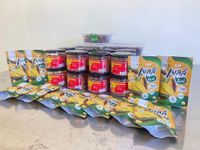On May 5, 2025, the Cambodian rice export sector reported impressive growth, with a total of 282,315 tons exported in the first four months of the year, generating revenues of $209 million, equivalent to approximately 6.87 billion baht. This surge in exports is largely attributed to the efforts of 48 companies that have successfully tapped into 59 countries and regions, with China remaining a key importer of Cambodian rice.
According to the report from the Federation of Cambodian Rice, the breakdown of rice exports reveals that 77.94% of the exported rice was fragrant rice, 17.15% was white rice, 2.47% was glutinous rice, 1.95% was organic rice, and the remaining 0.49% comprised other types. This diverse range of products showcases Cambodia's strong agricultural capabilities and its commitment to exporting quality produce.
The Ministry of Commerce of Cambodia has highlighted the positive impact of trade agreements such as the Regional Comprehensive Economic Partnership (RCEP) and the Cambodia-China Free Trade Agreement. These agreements have significantly reduced trade barriers, facilitating the export of high-quality agricultural products from Cambodia, including not only rice but also bananas, mangoes, longan, chilies, and seafood to China and other partner countries.
In a related development, the Isan Plaeng Yai community enterprise in Kalasin Province has been making strides in the export of safe watermelons. This community group, which began operations in 2015, has received certifications for Good Agricultural Practices (GAP) and is currently undergoing assessments for Good Manufacturing Practices (GMP) and FDA standards to ensure product safety and quality.
The enterprise has a total area of 300 rai and includes 31 members, all of whom have achieved GAP certification. The group's production methods emphasize sustainability, using innovative practices such as mini-sprinkler irrigation systems powered by solar energy, and organic fertilizers to replace chemical inputs. The focus on environmentally friendly practices aligns with the current global trend toward sustainable agriculture.
In terms of financial performance, the Isan Plaeng Yai community enterprise has generated over 4 million baht annually, with projections for future growth as they aim to increase both production and export volumes. The group is currently cultivating various watermelon varieties, including Nam Dok Mai, Khiao Sawoei, Chok Anan, and Kaew Lum Rang, with Nam Dok Mai being the most popular for export.
As of April 30, 2025, the market prices for Nam Dok Mai watermelons were reported at 48 baht per kilogram for export-grade fruit, while local market prices ranged from 4 to 10 baht per kilogram depending on size and quality. Additionally, the group has diversified its offerings by processing watermelons into various products, such as dried fruit and jelly, increasing their market reach and profitability.
Moreover, the Department of Foreign Trade in Thailand is taking measures to address challenges in exporting goods to the United States, particularly in light of a recent increase in tariffs to 36%. Director-General Arada Fuangthong announced the expansion of the list of goods under scrutiny from 49 to 65 items, which includes products such as solar panels and steel wheels. This move aims to prevent misrepresentation of product origins and to build confidence among U.S. customs officials.
The department's initiatives include enhancing the clarity of tariff codes and streamlining the process for exporters to obtain necessary documentation. In collaboration with the Thai Chamber of Commerce and the Federation of Thai Industries, the department has emphasized the importance of accurate product origin verification to avoid potential penalties and ensure a smooth export process.
In addition, the Department of Foreign Trade is promoting electronic payment systems to facilitate transactions for exporters. This initiative is part of a broader strategy to modernize trade practices and improve efficiency in export operations. As the department celebrates its 84th anniversary, it aims to strengthen Thailand's position in the global market by enhancing trade capabilities and supporting local entrepreneurs.
Overall, the developments in Cambodia's rice exports and Thailand's agricultural initiatives reflect a growing commitment to enhancing agricultural production and export capabilities in the region. With the support of government policies and international trade agreements, both countries are poised to expand their agricultural sectors and improve their economic prospects.

